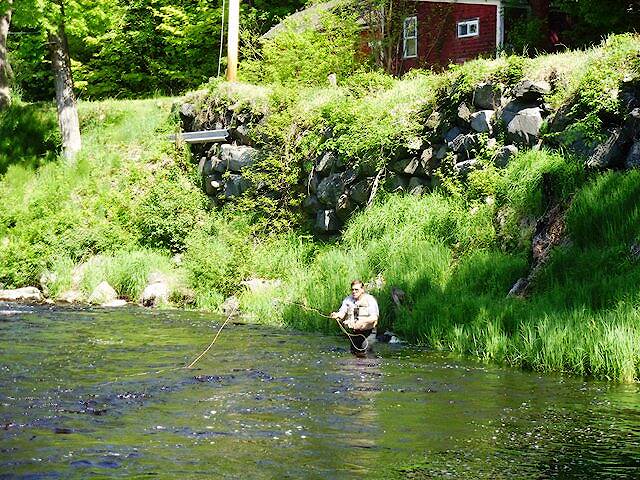
Hex Mayflies
Hexagenia limbata
The famous nocturnal Hex hatch of the Midwest (and a few other lucky locations) stirs to the surface mythically large brown trout that only touch streamers for the rest of the year.
Featured on the forum

This one seems to tentatively key to Holocentropus, although I can't make out the anal spines in Couplet 7 of the Key to Genera of Polycentropodidae Larvae nor the dark bands in Couplet 4 of the Key to Genera of Polycentropodidae Larvae, making me wonder if I went wrong somewhere in keying it out. I don't see where that could have happened, though. It might also be that it's a very immature larva and doesn't possess all the identifying characteristics in the key yet. If Holocentropus is correct, then Holocentropus flavus and Holocentropus interruptus are the two likely possibilities based on range, but I was not able to find a description of their larvae.

Troutnut is a project started in 2003 by salmonid ecologist Jason "Troutnut" Neuswanger to help anglers and
fly tyers unabashedly embrace the entomological side of the sport. Learn more about Troutnut or
support the project for an enhanced experience here.
NEMatt on Jul 7, 2014July 7th, 2014, 2:35 pm EDT
Hi,
Newbie here.
After reading Caucci's Hatches II, I've followed the step by step tying instructions for the compare-dun and the compare-emergers. I'd like to tie the compare-nymph next but he does't include SBS instructions for it. I can fumble through one from pictures but I'd like to know the proper way. Could anyone provide a link for me to follow? I would certainly appreciate it.
Also, thanks for all the good info sharing here - very helpful.
Matt
Newbie here.
After reading Caucci's Hatches II, I've followed the step by step tying instructions for the compare-dun and the compare-emergers. I'd like to tie the compare-nymph next but he does't include SBS instructions for it. I can fumble through one from pictures but I'd like to know the proper way. Could anyone provide a link for me to follow? I would certainly appreciate it.
Also, thanks for all the good info sharing here - very helpful.
Matt
NEMatt on Jul 7, 2014July 7th, 2014, 2:40 pm EDT
I meant 'compara' - auto spell check has killed me more than once.
Oldredbarn on Jul 8, 2014July 8th, 2014, 9:25 am EDT
Not a big deal...A rather simple, "guide-fly", type of fly.
Appropriate size hook for mayfly you are trying to imitate...Some use dry fly hook, some wet.
Wind thread on hook to rear of shank and dub a small bit of dubbing to facilitate the split tail...Tie in your stiff tailing fibers, either spade hackle or paint brush like tailing material and arrange so you have equal amounts on either side of dubbed ball...Wind thread tight up against this ball and they will split forming a nice v off the back of the hook.
Dub your tapered body a hook eye or two back from the eye.
Stack a small clump of appropriate color deer hair for wing...This is an emerger and the length of wing is open to debate, but start with wing tips about halfway back over the body...Wrap right up and against where the dubbing stopped.
Lift the butt ends up and tie in front of them, not unlike some tie an elk hair caddis, and whip finish. Then snip the butts at an angle with the wing...Again...Like an elk hair caddis.
If you have problems with the deer hair wanting to spin, don't let it...:) No...You can weave your thread through the butt hairs before you trim them...Craig Matthews, on his Sparkle Dun, divides the butts into thirds and places a firm wrap through the hair at each third...
Now...Other questions...Though a simple tie, what color should the emerger be? :)
Take a few moments to visit Charlie Cravens web site at www.charliesflyboxinc.com
Click on "Flybox" tab to the right and view each of his listed patterns...Each has a wonderful step-by-step tutorial.
You'll be tying like a pro in no-time!
Spence
Appropriate size hook for mayfly you are trying to imitate...Some use dry fly hook, some wet.
Wind thread on hook to rear of shank and dub a small bit of dubbing to facilitate the split tail...Tie in your stiff tailing fibers, either spade hackle or paint brush like tailing material and arrange so you have equal amounts on either side of dubbed ball...Wind thread tight up against this ball and they will split forming a nice v off the back of the hook.
Dub your tapered body a hook eye or two back from the eye.
Stack a small clump of appropriate color deer hair for wing...This is an emerger and the length of wing is open to debate, but start with wing tips about halfway back over the body...Wrap right up and against where the dubbing stopped.
Lift the butt ends up and tie in front of them, not unlike some tie an elk hair caddis, and whip finish. Then snip the butts at an angle with the wing...Again...Like an elk hair caddis.
If you have problems with the deer hair wanting to spin, don't let it...:) No...You can weave your thread through the butt hairs before you trim them...Craig Matthews, on his Sparkle Dun, divides the butts into thirds and places a firm wrap through the hair at each third...
Now...Other questions...Though a simple tie, what color should the emerger be? :)
Take a few moments to visit Charlie Cravens web site at www.charliesflyboxinc.com
Click on "Flybox" tab to the right and view each of his listed patterns...Each has a wonderful step-by-step tutorial.
You'll be tying like a pro in no-time!
Spence
"Even when my best efforts fail it's a satisfying challenge, and that, after all, is the essence of fly fishing." -Chauncy Lively
"Envy not the man who lives beside the river, but the man the river flows through." Joseph T Heywood
"Envy not the man who lives beside the river, but the man the river flows through." Joseph T Heywood
Tctrout
Posts: 28
Posts: 28
Tctrout on Jul 8, 2014July 8th, 2014, 4:08 pm EDT
Here's a Sparkle Dun that is tied with deer hair. It's similar to a comparadun, though the tail is tied out of zelon, antron, etc. Good luck!
http://www.youtube.com/watch?v=7QwBuaqWjfo
TC
http://www.youtube.com/watch?v=7QwBuaqWjfo
TC
Johnvan61 on Jul 9, 2014July 9th, 2014, 5:19 am EDT
Whats a compara nymph? The one above sounds like a compara emerger. I have tied a compara dun following instructions in Kaufmann's fly tying book and have seen the compara emerger using deer hair for emerging wing but I don't ever recall seeing a compara nymph. Are there illustrations somewhere? Thanks---John
"my mind is like oatmeal"
Entoman on Jul 9, 2014July 9th, 2014, 9:15 am EDT
The compara-nymph is not a style or type of nymph. What the authors did was take the generic Skues "pulled over wingcase" style and use their dubbing blends to match the hatch in sync with their other "compara" patterns. Absolutely nothing unique about them and as Spence mentioned they are "guide flies", i.e. as simple as you can get. There are literally hundreds of instructional videos on YouTube or similar venues that show how to tie a Gold-ribbed Hare's Ear or similar nymph. Pick the one you like best, substitute dubbing and leave out the ribbing. That's a compara- nymph...
"It's not that I find fishing so important, it's just that I find all other endeavors of Man equally unimportant... And not nearly as much fun!" Robert Traver, Anatomy of a Fisherman
NEMatt on Jul 9, 2014July 9th, 2014, 10:17 pm EDT
Not a big deal...A rather simple, "guide-fly", type of fly.
Appropriate size hook for mayfly you are trying to imitate...Some use dry fly hook, some wet.
Wind thread on hook to rear of shank and dub a small bit of dubbing to facilitate the split tail...Tie in your stiff tailing fibers, either spade hackle or paint brush like tailing material and arrange so you have equal amounts on either side of dubbed ball...Wind thread tight up against this ball and they will split forming a nice v off the back of the hook.
Dub your tapered body a hook eye or two back from the eye.
Stack a small clump of appropriate color deer hair for wing...This is an emerger and the length of wing is open to debate, but start with wing tips about halfway back over the body...Wrap right up and against where the dubbing stopped.
Lift the butt ends up and tie in front of them, not unlike some tie an elk hair caddis, and whip finish. Then snip the butts at an angle with the wing...Again...Like an elk hair caddis.
If you have problems with the deer hair wanting to spin, don't let it...:) No...You can weave your thread through the butt hairs before you trim them...Craig Matthews, on his Sparkle Dun, divides the butts into thirds and places a firm wrap through the hair at each third...
Now...Other questions...Though a simple tie, what color should the emerger be? :)
Take a few moments to visit Charlie Cravens web site at www.charliesflyboxinc.com
Click on "Flybox" tab to the right and view each of his listed patterns...Each has a wonderful step-by-step tutorial.
You'll be tying like a pro in no-time!
Spence
Perfect. Thanks for taking the time to type that up. Very Helpful.
Quick Reply
Related Discussions
Topic
Replies
Last Reply
9
Jun 16, 2015
by Oldredbarn
by Oldredbarn
4
May 17, 2010
by Lastchance
by Lastchance





